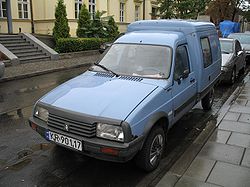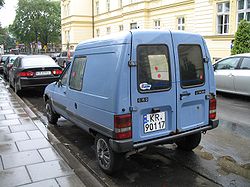- Citroën C15
-
Citroën C15 
Manufacturer Citroën Production 1984—2005 Predecessor Citroën Acadiane Successor Citroën Berlingo Class Panel van Body style Van Layout FF layout Related Citroën Visa The Citroën C15 was a panel van produced by the French manufacturer Citroën from 1984 until 2005. It was the successor the Citroën 2CV vans that pioneered the box van format from the 1950s to the 1980s.
The C15 was based on the Citroën Visa (discontinued 1988), and mainly used a 1769cc XUD or 1868cc (DW8 on late models), naturally aspirated (non-turbo) diesel engine. Until the early 1990s it was also available with a petrol PSA TU engine. As well as standard van configuration, the vehicle was available with rear side-windows and a rear seat, (which had been pioneered in the 2CV), which can be seen as a forerunner to today's utility vehicles such as the Ford Transit Connect, Opel/Vauxhall Combo, Citroën Berlingo and Peugeot Partner. The C15 was available without the rear box section, as a 'chassis only' model. Rare pickup truck versions were also made.
In 2005, production reached 1,181,471, the last three of which were given to:
- The government of Vigo city in Spain, where the production of this car was held for last few years
- Museum of Citroën cars in Aulnay
- One of Vigo car factory workers
Over its 21 year production run, there were various minor changes and upgrades made. Models with 600 kg and 800 kg load capacities were introduced (the original was 500 kg). Trim details were changed to give it a facelift in the early 1990s: side plastic trims were added, and the bonnet trim changed.
The design was simple, but very reliable and effective, resulting in a remarkably successful 21-year production run, in comparison to the Visa hatchback from which it was derived, which was produced for only ten years. The C15 had a lengthened wheelbase, and a rear axle taken from the Peugeot 305 break. The vehicle is very basic by modern standards, but this made it cheap to build, cheap to run and hard to break.
The availability of the vehicle with a 'chassis only' rear portion encouraged various conversions. The C15 was used as a camper-van base by Island Plastics, branding the resulting vehicle the RomaHome. It was a surprisingly practical small camper for two people.
Variants and history
The C15 was introduced in the UK in 1985, initially badged with the pun 'van blanc' or 'van rouge' according to body colour. UK models were always shipped without rear side windows, as is usual for UK vans, due to tax regulations. European models had side windows, and a 'combi' version with a rear bench seat. There was also, in France at least, a rather rare 'stretched' version, which was about 0.5m longer than a normal C15.
Early models had a single wide rear door, but this was awkward for loading in a tight space and prone to sagging or to snapping off in a high wind, so, after a year or two, only conventional 2-door versions were sold with fold back hinges.
The engine used was the extremely rugged and reliable PSA XUD series: XUD7 (1.7l) and (DW8 1.9l on later models). It also powered vehicles several classes larger, and made light work of powering the lightweight C15. Both Bosch and Lucas/CAV/Roto-diesel injection systems were used. A small number of TU petrol engined versions were also sold until the early 1990s. The engines and drivetrains were originally taken from the Peugeot 205 and were the same as fitted to the diesel Citroën Visa.
Numerous changes were made to the engine ancillaries over the years. Early models had an in-line electrical diesel heater, which invariably stopped working after a couple of years, but made no difference, unless used in very cold conditions, so it wasn't fitted on later UK models, the fuel passing over the thermostat housing to warm it up instead. The fuel filter moved from the wing to the top of the thermostat housing. The oil filler moved from the crankcase cover to the dipstick housing.
The front indicators were originally combined with the headlights, but later replaced by side lights (moved from the headlight reflector) and separate indicators were fitted in the bumper.
External links
Citroën PSA Peugeot Citroën · Category · Vehicles
Current - Europe Current - China (DPCA) Historic Trucks Concept cars G Van · Prototype C · Prototype Y · 2CV Pop · GS Camargue · C44 · Karin · Zabrus · Activa · C6 Lignage · C-SportLounge · C-Airplay · C-Buggy · C-Airdream · GT by Citroën · Hypnos · DS Inside · Revolte · Survolt · C-CactusMotorsport Electric vehicle « previous — Automobiles Citroën, a subsidiary of the PSA Peugeot Citroën since 1976, car timeline, 1980s–present Type 1980s 1990s 2000s 2010s 0 1 2 3 4 5 6 7 8 9 0 1 2 3 4 5 6 7 8 9 0 1 2 3 4 5 6 7 8 9 0 1 Economy car 2CV Off-roader Méhari City car C1 Supermini LN / LNA AX Dyane Axel Saxo I Saxo II C2 DS3 Visa C3 I C3 II Small family car GSA ZX Xsara I Xsara II C4 I C4 II DS4 Large family car BX Xantia C5 I C5 II DS5 Executive car CX XM C6 Leisure
activity vehicleAcadiane C15 Nemo Berlingo Berlingo II Compact
MPVXsara Picasso C3 Picasso C4 Picasso Large MPV Evasion/Synergie C8 C4 Grand Picasso Crossover C-Crosser Convertible C3 Pluriel Van H Van C25 Jumpy I Jumpy II C35 Jumper Jumper II Categories:- Citroën vehicles
- Vans
- Vehicles introduced in 1984
Wikimedia Foundation. 2010.

